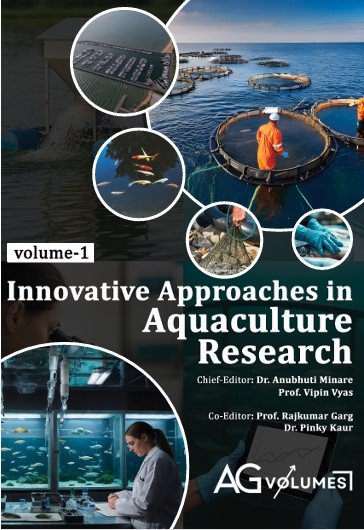To study the present status of Wetlands and Rivers and its diversity near Bhopal district, Madhya Pradesh
Keywords:
Present Status, Diversity, Wetlands, RiversAbstract
The present study was conducted to assess the current status of wetlands and riverine fish diversity in and around the Bhopal district of Madhya Pradesh, with specific focus on regions including Bhopal, Sehore, and Berasia. Field surveys were carried out from multiple water bodies such as the Upper and Lower Lakes of Bhopal (Bhoj Wetlands), the Parbati River in Sehore, and various ponds and reservoirs in Berasia including Goretia Talab, Sagoni Kalan, and Semri Kalan. Data were collected through field observations, interaction with local fishers and vendors, and secondary data sources including scientific literature and IUCN assessments. A total of 54 fish species belonging to 12 orders and 23 families were recorded, with Cyprinidae being the most dominant family comprising 20 species, followed by Bagridae and Channidae. The study noted a concerning decline in the population of Small Indigenous Fish species (SIF), attributed to the presence of invasive and predatory species like Hypophthalmichthys molitrix and Clarias gariepinus, along with anthropogenic pressures such as pollution, habitat degradation, siltation, and unregulated aquaculture. According to the IUCN Red List, the majority of species observed were categorized as Least Concern, while others such as Tor tor were listed as Endangered, Wallago attu as Vulnerable, and species like Ompok bimaculatus and Chitala chitala as Near Threatened or Data Deficient. This study highlights the rich yet threatened fish biodiversity of the Bhopal region and underscores the urgent need for conservation efforts. Recommended strategies include controlling invasive species, promoting sustainable aquaculture, preventing overharvesting, and restoring natural wetland habitats. These actions are vital for preserving the ecological integrity of central India’s freshwater ecosystems and safeguarding indigenous aquatic biodiversity for future generations.
References
[1] Tapan Kumar Deka, M. Kakati, and M.M. Goswami. Diversity Of Wetland Fish and Its on the income of Fisheries Community Of Assam. Journal of the Indian Fisheries Association; (2001): Vol. 11 No. 22
[2] Arya, S. C.; Rao, K. S. and Shrivastava, S. (2001): Biodiversity and Fishery Potential of Narmada Basin Western Zone (M. P. India) with special reference to Fish Conservation. Environment and Agriculture : Agriculture and Pollution in South Asia, pp. 108-112
[3] Prasad S N, Ramachandra T V, Ahalya N, Sengupta T, Kumar A, Tiwari A K, Vijayan V S and Vijayan l. Energy and wetlands research group. 2002; Tropical Ecology, 43 (1): 173-186.
[4] Devashish Kar 1, A.V. Nagarathna 2, T.V. Ramachandra 3 and S.C. Dey 4. Fish diversity and conservation aspects in an aquatic ecosystem in northeastern india. zoos' print journal; (2003): 21(7): 2308-2315.https://doi.org/10.11609/JoTT.ZPJ.1437a.2308-15
[5] Bhat A, Diversity And Composition of Freshwater fishes In River system of Central ghats, India. Environmental Biology of Fishes. 2003; 68, pages25-38.https://doi.org/10.1023/A:1026017119070
[6] Ramesh C.Sharma, geetu Bhanot, Deepak Singh. Aquatic Macroinvertebrate Diversity in Nanda Devi Biosphere Reserve, India. Environmentalist System and decisions; (2004): Vol. 24, 211-221.https://doi.org/10.1007/s10669-005-0996-z
[7] Maheshwari, U. K. (2004). Ichthyobiodiversity, Decline Pattern, Management and Conservation of Natural Seed of Mahseer Tor tor in middle stretch of River Narmada, Nature Conservation, 8: 111- 117.
[8] Mohsin A B M, Haque Emdadul, Diversitry of Fishes of Mahananda River At Chapai Nawabgonj District. Research Journal of Biological Sciences. 2009; Volume 4 Issue 7.
[9] Devi prasad et al., (2009). Fish diversity and its conservation in major Wetlands of Mysore. Journal of Environmental Biology Vol. 30 (5), pp. 713-718.
[10] Hossain M S, Das G N, Sarker S, Fish diversity and habitat relationship with environmental variables at Meghna river estuary, Bangladesh. The Egyptian journal of Aquatic research. 2012; Volume 38, Issue 3.https://doi.org/10.1016/j.ejar.2012.12.006
[11] Karamchandani, S. J.; Desai, V. R.; Pisolker, M. D. and Bhatnagar, G. K. (1967). Biological investigation on the fish and fisheries of Narmada River (1958-66). Bull Cent. Inland Fish. Res. Inst., Barrackpore (Mimeo), 10: 40.
[12] Nikam D S, Shaikh A L, Salunkhe P S, Kamble AB, Rao A B, Ichthyofaunal Diversity of Ashti Lake, Tal. Mohol, Dist. Solapur. Global journal for research analysis. 2014; Volume 3, Issue 12, SSN No 2277 - 8160
[13] S.Dey, M.Manorama, S.N Ramanujam. New records of three species of fish in the upper reaches of Brahmaputra and Surma-Meghna river basins, Meghalaya, India. Journal of threatened taxa; (2015): Vol. 7 No. 12.https://doi.org/10.11609/JoTT.o3297.7922-6
[14] Bhushan Kumar Sharma, Mrinal Kumar Hatimuria, Sumita Sharma. Ecosystem diversity of Cladocera(Crrustacea:Branchiopoda) of the floodplains lakes of Majuli River Island, The Brahmaputra river Basin, Northeast India. International Journal of Aquatic Biology; (2015): Vol. 3 No 2.
[15] N. A. Raushon1, M. G. S. Riar1, Sonia, Sku, L. Majumder and M. S. Haq2. Fish Diversity of the old Brahmaputra river, Mymensingh. Journal Binet; (2017); Vol. 13 Issue 01:1109-1115.https://doi.org/10.18801/jbar.130117.135
[16] Singh, J. S. ; Chaturvedi, R. K. Diversity of ecosystem types in India. Indian academy of Sciences 2017; 83 (2): 0370-0046.https://doi.org/10.16943/ptinsa/2017/41287
[17] Nath A K, Patra A, Survey on the present status of Fish Species Diversity in a stretch of Hooghly River ans Inland Areas Of Hooghly District of West Bengal, India. htttp://www.ijcmas.com. 2017; Volume 6 Number 7 (2017) pp. 4260-4266.https://doi.org/10.20546/ijcmas.2017.607.441
[18] Kakodiya S K and Mehra S Fish diversity of narmada river at hoshangabad, madhya pradesh. IJRAR. 2018; Volume 5, Issue 3
[19] Kushal T, Kumar R, Bhavna A Review on Freshwater Fish Diversity of India and Concept of DNA Barcoding in Fish Identification. www.ejabf.journal.ekb.eg . 2021; . 25(3): 667 - 693.https://doi.org/10.21608/ejabf.2021.179996




